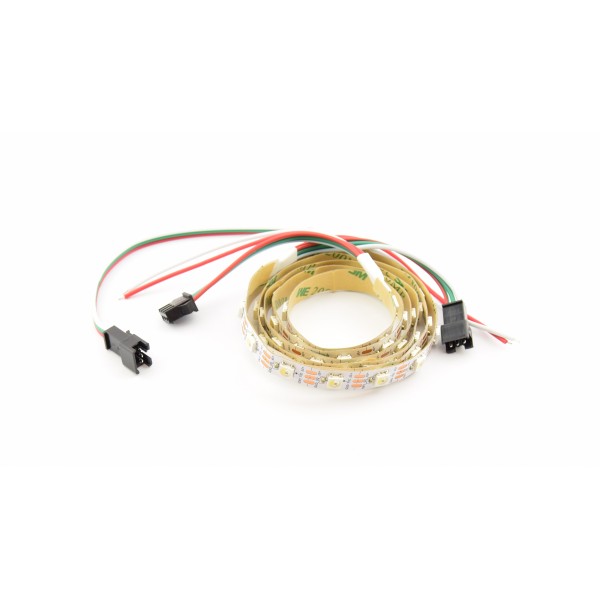SK6812 Digital 5050 RGBWW LED Strip - 60 LEDs 1m - Warm White
- Availability: Directly available from warehouse in Eindhoven
- SKU: 003072
€12.50
Ex Tax: €10.33
Your shopping cart is empty!

This product is a SK6812 RGBW LED Strip with 60 LEDs on 1 meter. This LED strip has an extra warm white LED in each module for better warm white color reproduction. Each LED can be cut separately from the LED Strip. This way you can shorten or extend the LED strip. Underneath the LEDs there is double-sided tape to mount the strip.
The color of the LED is controlled by the built-in chip. You can place a lot of these LEDs behind each other and control them digitally with just 1 pin. The LED strip is powered with 5V.
You can place up to 1024 LEDs in succession and then still achieve 30fps (30 changes per second).
The LED is of the RGB+W type with which each color can be controlled with 8 bits. This allows each LED to display 4294967296 types of colors (32 bits).
Various platforms offer support for this LED with the help of libraries, including Arduino.
More information for the Arduino platform can be found here: Adafruit NeoPixel Überguide.
Meaning of the color of the wires:
Dimensions: 10x2x1000mm
The datasheet of the LED can be found under the tab "Downloads" (LED version: "Warm Sunlight").
This product is supplied in parts of 1 meter, with each meter of LED Strip in a separate package.
You can then attach these LED strips to each other by clicking the connectors together at the ends of the strips.
If you want the strips to be close together, you have to solder them together yourself.
Note: The LED strip has a power of 0.25W per LED module (50mA@5V) regardless of the color. So, a LED strip of 60 LEDs draws around 3A. You should take this into account when powering the LED strip.
Note: Make sure that the LED strip on the meter gives an "extra" 5V voltage. This is because the voltage drops over the strip and the current at the start can rise quite nicely (and perhaps the start of your LED strip burns out!).
You can read more about this here: Powering Neopixels.
Check the tab "Downloads" for more information and/or downloads.
This product has 0 review(s) in total.
Datasheet: 003072_SK6812_RGBW_datasheet.pdf
Use a stable, CE-approved power supply with the correct voltage that can supply sufficient current. The maximum current that an LED can draw is indicated on the product page. Multiply this number by the number of LEDs to calculate the total maximum current. This maximum current is the minimum current that the power supply must be able to supply.
To connect a digital LED strip, we offer two options below. The first is recommended as it requires fewer components and fewer connections.
Requirements:
The following components are required to operate a product with digital LEDs:
Connecting the strip:
*There are many power supplies on the market that carry a China export ("fake" CE marking) or carry a CE marking but are not actually CE certified. We advise against using these, often cheap (Chinese), power supplies because they often do not provide a stable voltage. A stable voltage is essential to prevent damage to the LED strips and to ensure stable operation.
Requirements:
The following components are required to operate a product with digital LEDs:
The following parts are optional:
Connecting the strip:
*There are many power supplies on the market that have a China Export ("fake" CE marking) or carry a CE marking, but are in reality not CE approved. We do not recommend using these, often cheap (Chinese), power supplies because they generally do not provide a stable voltage. A stable voltage is essential to make the LEDS work stable, and to prevent damaging them.
More information:
We recommend reading the following pages for more information (especially when using multiple LED strips): Powering Neopixels and Adafruit NeoPixel Überguide.
This can have several causes. The most common causes are:
Signal voltage too low
For example, WS2812B LEDs have a signal voltage of 5V. When these are controlled with a voltage of 3.3V (as with ESP32/ESP8266/Raspberry Pi), data may not be properly received at one or more LEDs, resulting in the wrong color. This can be solved by increasing the signal voltage to 5V using a level converter.
Noise on the signal pin
The signal pin is sensitive to noise. This can be solved by connecting a 470Ω resistor in series between the microcontroller and the signal pin of the LEDs.
Voltage drop in supply voltage
Particularly with many LEDs in succession, it can happen that a part does not display the right color. This may be a sign that the supply voltage has dropped too far due to losses in the cabling. This can be solved by using extra thick power cables and connecting them between each strip.